Stewart J. Calculus
Подождите немного. Документ загружается.

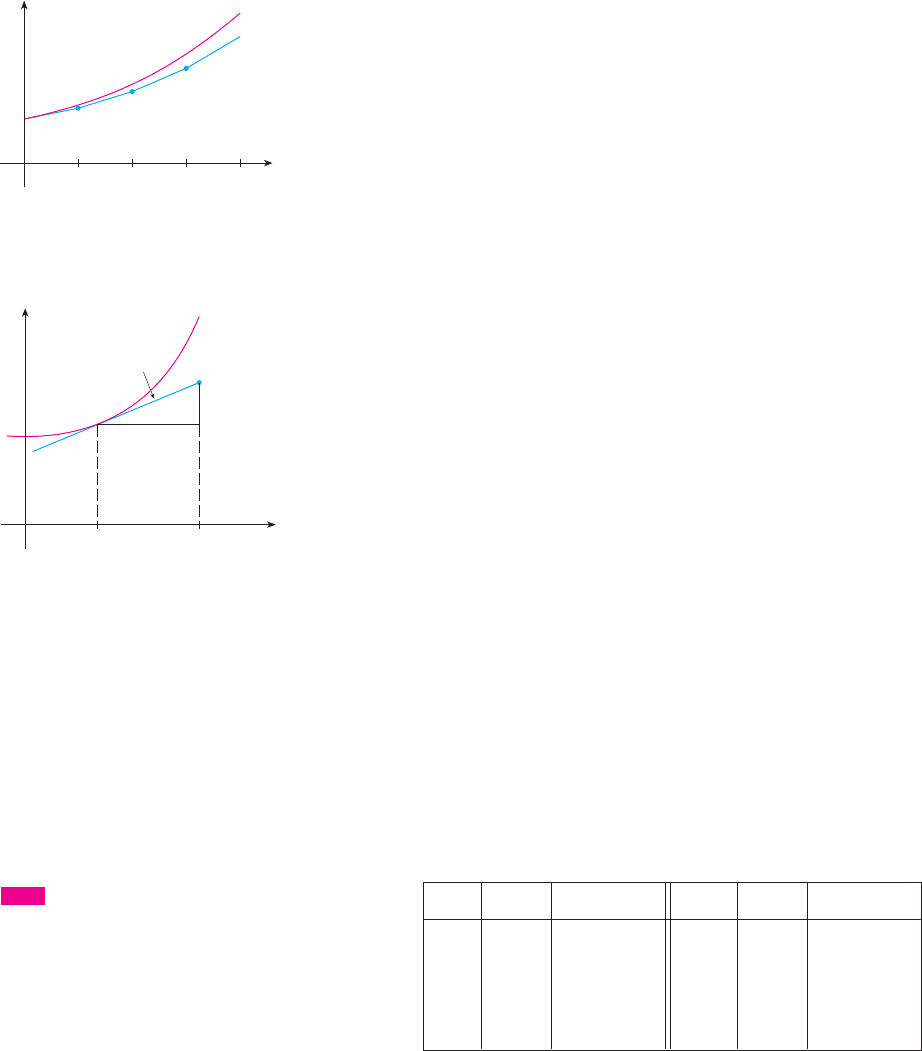
as an approximation to the solution for (the orange segment in Figure 13). If we
decrease the step size from to , we get the better Euler approximation shown in
Figure 14.
In general, Euler’s method says to start at the point given by the initial value and pro-
ceed in the direction indicated by the direction field. Stop after a short time, look at the
slope at the new location, and proceed in that direction. Keep stopping and changing direc-
tion according to the direction field. Euler’s method does not produce the exact solution to
an initial-value problem—it gives approximations. But by decreasing the step size (and
therefore increasing the number of midcourse corrections), we obtain successively better
approximations to the exact solution. (Compare Figures 12, 13, and 14.)
For the general first-order initial-value problem , , our aim is to
find approximate values for the solution at equally spaced numbers , ,
, . . . , where is the step size. The differential equation tells us that the slope
at is , so Figure 15 shows that the approximate value of the solution
when is
Similarly,
In general,
EXAMPLE 3 Use Euler’s method with step size to construct a table of approximate
values for the solution of the initial-value problem
SOLUTION We are given that , , , and . So we have
This means that if is the exact solution, then .
Proceeding with similar calculations, we get the values in the table:
M
For a more accurate table of values in Example 3 we could decrease the step size. But
for a large number of small steps the amount of computation is considerable and so we
need to program a calculator or computer to carry out these calculations. The following
table shows the results of applying Euler’s method with decreasing step size to the initial-
value problem of Example 3.
y!0.3" # 1.362y!x"
y
3
! y
2
! hF!x
2
, y
2
" ! 1.22 ! 0.1!0.2 ! 1.22" ! 1.362
y
2
! y
1
! hF!x
1
, y
1
" ! 1.1 ! 0.1!0.1 ! 1.1" ! 1.22
y
1
! y
0
! hF!x
0
, y
0
" ! 1 ! 0.1!0 ! 1" ! 1.1
F!x, y" ! x ! yy
0
! 1x
0
! 0h ! 0.1
y!0" ! 1y" ! x ! y
0.1
y
n
! y
n#1
! hF!x
n#1
, y
n#1
"
y
2
! y
1
! hF!x
1
, y
1
"
y
1
! y
0
! hF!x
0
, y
0
"
x ! x
1
y" ! F!x
0
, y
0
"!x
0
, y
0
"
hx
2
! x
1
! h
x
1
! x
0
! hx
0
y!x
0
" ! y
0
y" ! F!x, y"
0.250.5
x $ 0.5
612
|| ||
CHAPTER 10 DIFFERENTIAL EQUATIONS
n n
1 0.1 1.100000 6 0.6 1.943122
2
0.2 1.220000 7 0.7 2.197434
3 0.3 1.362000 8 0.8 2.487178
4 0.4 1.528200 9 0.9 2.815895
5 0.5 1.721020 10 1.0 3.187485
y
n
x
n
y
n
x
n
y
x
⁄x¸
0
y¸
h
h F(x¸,y¸)
(⁄,›)
slope=F(x¸,y¸)
F I G U R E 1 5
y
x0
1
1
0.25
F I G U R E 1 4
Euler approximation with step size 0.25
Module 10.2B shows how Euler’s
method works numerically and visually
for a variety of differential equations and
step sizes.
TE C
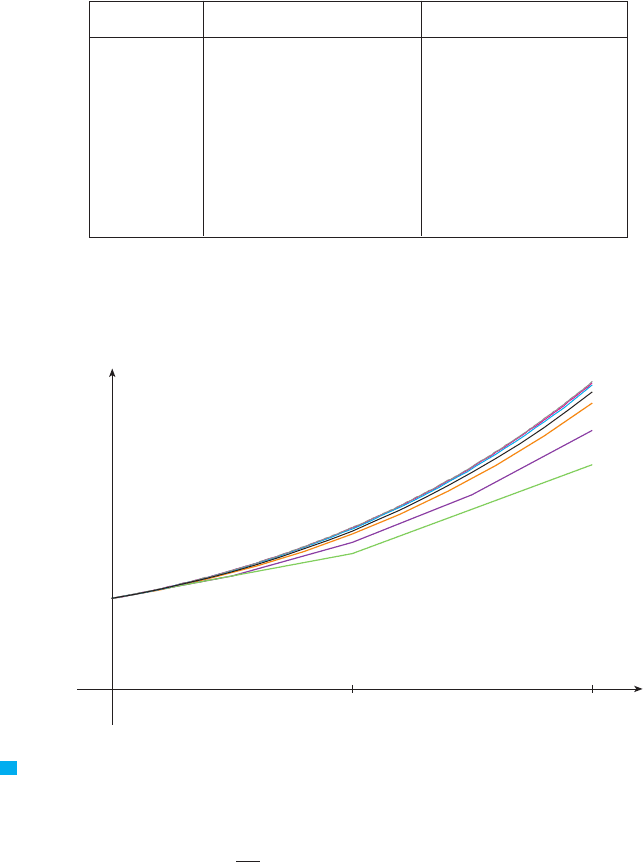
Notice that the Euler estimates in the table seem to be approaching limits, namely, the
true values of and . Figure 16 shows graphs of the Euler approximations with
step sizes 0.5, 0.25, 0.1, 0.05, 0.02, 0.01, and 0.005. They are approaching the exact solu-
tion curve as the step size h approaches 0.
EXAMPLE 4 In Example 2 we discussed a simple electric circuit with resistance
, inductance 4 H, and a battery with voltage 60 V. If the switch is closed when
, we modeled the current I at time t by the initial-value problem
Estimate the current in the circuit half a second after the switch is closed.
SOLUTION We use Euler’s method with , and step size
second:
So the current after 0.5 seconds is
MI!0.5" # 4.16 A
I
5
! 3.7995 ! 0.1!15 # 3 ! 3.7995" ! 4.15965
I
4
! 3.285 ! 0.1!15 # 3 ! 3.285" ! 3.7995
I
3
! 2.55 ! 0.1!15 # 3 ! 2.55" ! 3.285
I
2
! 1.5 ! 0.1!15 # 3 ! 1.5" ! 2.55
I
1
! 0 ! 0.1!15 # 3 ! 0" ! 1.5
h ! 0.1
F!t, I" ! 15 # 3I, t
0
! 0, I
0
! 0
I!0" ! 0
dI
dt
! 15 # 3I
t ! 0
12 %
V
0 x
y
0.5 1
1
F I G U R E 1 6
Euler approximations
approaching the exact solution
y!1"y!0.5"
SECTION 10.2 DIRECTION FIELDS AND EULER’S METHOD
|| ||
613
Step size Euler estimate of Euler estimate of
0.500 1.500000 2.500000
0.250
1.625000 2.882813
0.100 1.721020 3.187485
0.050 1.757789 3.306595
0.020 1.781212 3.383176
0.010 1.789264 3.409628
0.005 1.793337 3.423034
0.001 1.796619 3.433848
y!1"y!0.5"
N Computer software packages that produce
numerical approximations to solutions of
differential equations use methods that are
refinements of Euler’s method. Although Euler’s
method is simple and not as accurate, it is the
basic idea on which the more accurate methods
are based.
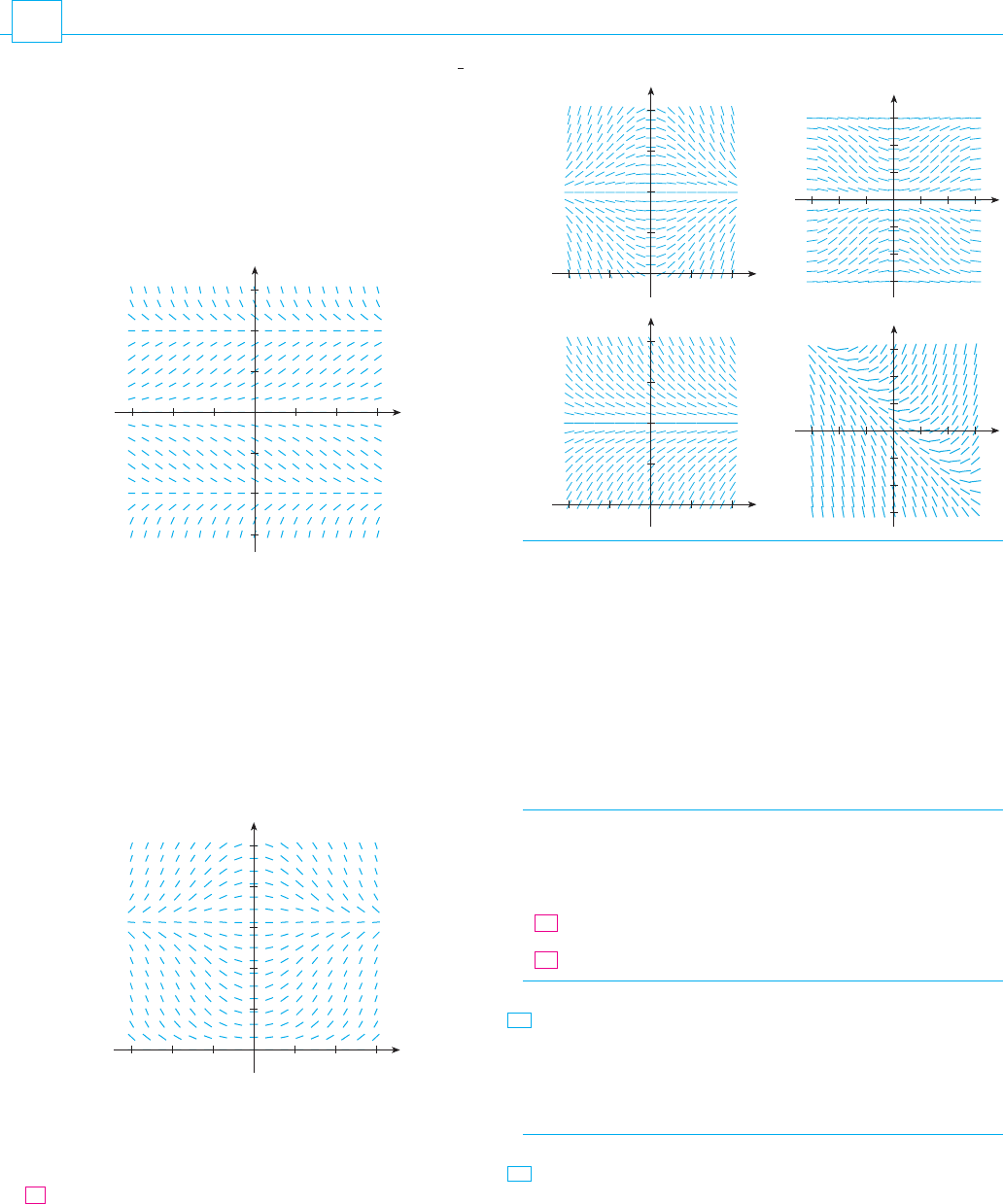
614
|| ||
CHAPTER 10 DIFFERENTIAL EQUATIONS
5. 6.
7. Use the direction field labeled II (above) to sketch the graphs
of the solutions that satisfy the given initial conditions.
(a) (b) (c)
8. Use the direction field labeled IV (above) to sketch the graphs
of the solutions that satisfy the given initial conditions.
(a) (b) (c)
9–10 Sketch a direction field for the differential equation. Then
use it to sketch three solution curves.
9. 10.
11–14 Sketch the direction field of the differential equation.
Then use it to sketch a solution curve that passes through the
given point.
,
12. ,
,
14. ,
15–16 Use a computer algebra system to draw a direction field
for the given differential equation. Get a printout and sketch on it
the solution curve that passes through . Then use the CAS to
draw the solution curve and compare it with your sketch.
15. 16.
17. Use a computer algebra system to draw a direction field for
the differential equation . Get a printout and y" ! y
3
# 4y
CAS
y" ! x!y
2
# 4"y" ! x
2
sin y
!0, 1"
CAS
!1, 0"y" ! x # xy!0, 1"y" ! y ! x y
13.
!0, 0"y" ! 1 # x y!1, 0"y" ! y # 2x
11.
y" ! x
2
# y
2
y" ! 1 ! y
y!0" ! 1y!0" ! 0y!0" ! #1
y!0" ! #1y!0" ! 2y!0" ! 1
y
0
x
4
2_2
2
y
0
x
2_2
2
_2
y
0
x
4
2_2
2
y
0
x
2_2
2
_2
I II
III IV
y" ! sin x sin yy" ! x ! y # 1
1. A direction field for the differential equation
is shown.
(a) Sketch the graphs of the solutions that satisfy the given
initial conditions.
(i) (ii)
(iii) (iv)
(b) Find all the equilibrium solutions.
2. A direction field for the differential equation is
shown.
(a) Sketch the graphs of the solutions that satisfy the given
initial conditions.
(i) (ii) (iii)
(iv) (v)
(b) Find all the equilibrium solutions.
3–6 Match the differential equation with its direction field
(labeled I–IV). Give reasons for your answer.
4. y" ! x!2 # y"y" ! 2 # y
3.
y
0
x
3
3_3
5
4
1 2_1_2
1
2
y!0" ! 5y!0" ! 4
y!0" !
&
y!0" ! 2y!0" ! 1
y" ! x sin y
y
0
x
3
3_3
_3
1 2_1_2
1
2
_1
_2
y!0" ! 3y!0" ! #3
y!0" ! #1y!0" ! 1
y" ! y
(
1 #
1
4
y
2
)
E X E R C I S E S
10.2
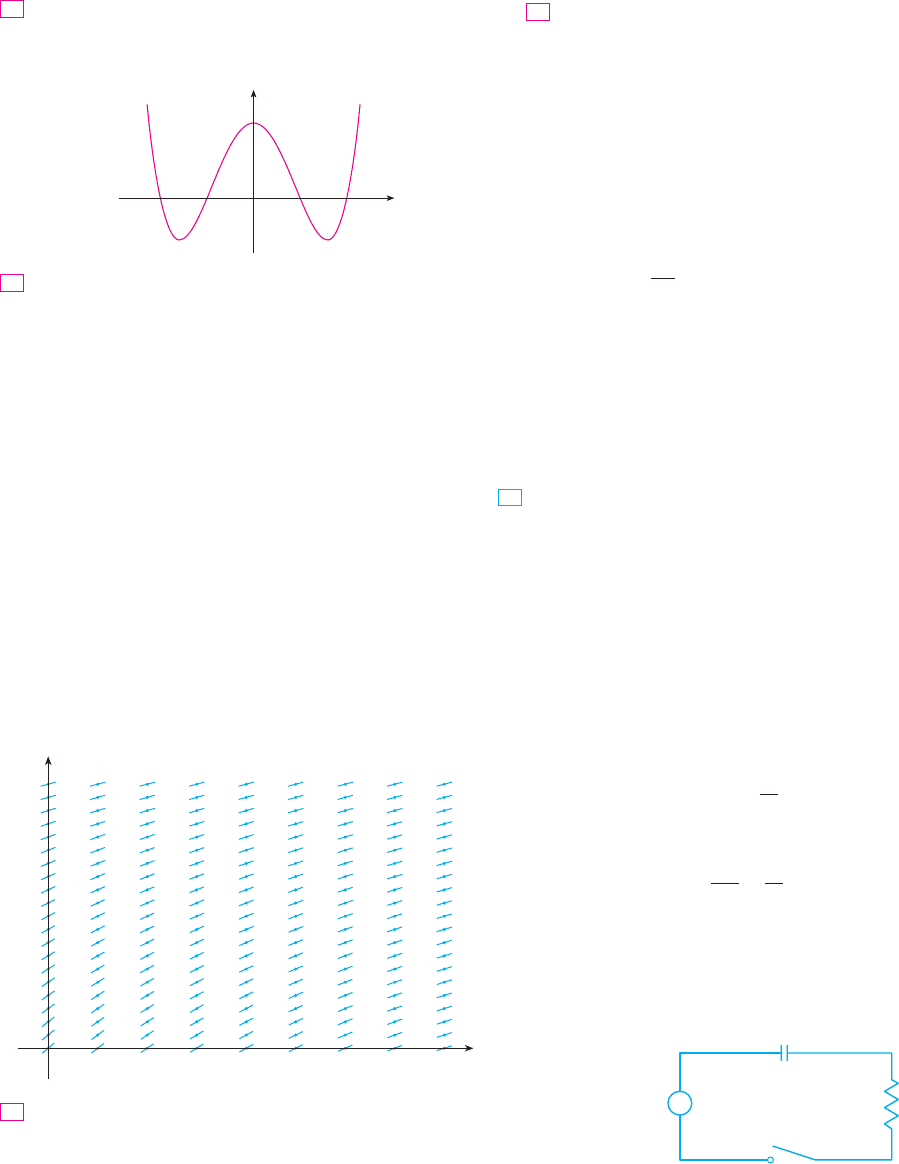
22. Use Euler’s method with step size to estimate , where
is the solution of the initial-value problem ,
.
Use Euler’s method with step size to estimate ,
where is the solution of the initial-value problem
, .
24. (a) Use Euler’s method with step size to estimate ,
where is the solution of the initial-value problem
, .
(b) Repeat part (a) with step size .
;
25. (a) Program a calculator or computer to use Euler’s method
to compute , where is the solution of the initial-
value problem
(i) (ii)
(iii) (iv)
(b) Verify that is the exact solution of the
differential equation.
(c) Find the errors in using Euler’s method to compute
with the step sizes in part (a). What happens to the error
when the step size is divided by 10?
26. (a) Program your computer algebra system, using Euler’s
method with step size 0.01, to calculate , where
is the solution of the initial-value problem
(b) Check your work by using the CAS to draw the solution
curve.
27. The figure shows a circuit containing an electromotive force,
a capacitor with a capacitance of farads (F), and a resistor
with a resistance of ohms ( ). The voltage drop across the
capacitor is , where is the charge (in coulombs), so in
this case Kirchhoff’s Law gives
But , so we have
Suppose the resistance is , the capacitance is F, and a
battery gives a constant voltage of 60 V.
(a) Draw a direction field for this differential equation.
(b) What is the limiting value of the charge?
C
E
R
0.05%5
R
dQ
dt
!
1
C
Q ! E!t"
I ! dQ$dt
RI !
Q
C
! E!t"
QQ$C
%R
C
y!0" ! 1y" ! x
3
# y
3
yy!2"
CAS
y!1"
y ! 2 ! e
#x
3
h ! 0.001h ! 0.01
h ! 0.1h ! 1
y!0" ! 3
dy
dx
! 3x
2
y ! 6x
2
y!x"y!1"
0.1
y!1" ! 0y" ! x # xy
y!x"
y!1.4"0.2
y!0" ! 1y" ! y ! xy
y!x"
y!0.5"0.1
23.
y!0" ! 0
y" ! 1 # x yy!x"
y!1"0.2
sketch on it solutions that satisfy the initial condition
for various values of . For what values of does
exist? What are the possible values for this limit?
Make a rough sketch of a direction field for the autonomous
differential equation , where the graph of is as
shown. How does the limiting behavior of solutions depend
on the value of ?
(a) Use Euler’s method with each of the following step sizes
to estimate the value of , where is the solution of
the initial-value problem .
(i) (ii) (iii)
(b) We know that the exact solution of the initial-value
problem in part (a) is . Draw, as accurately as you
can, the graph of , together with the
Euler approximations using the step sizes in part (a).
(Your sketches should resemble Figures 12, 13, and 14.)
Use your sketches to decide whether your estimates in
part (a) are underestimates or overestimates.
(c) The error in Euler’s method is the difference between
the exact value and the approximate value. Find the errors
made in part (a) in using Euler’s method to estimate the
true value of , namely . What happens to the
error each time the step size is halved?
20. A direction field for a differential equation is shown. Draw,
with a ruler, the graphs of the Euler approximations to the
solution curve that passes through the origin. Use step sizes
and . Will the Euler estimates be under-
estimates or overestimates? Explain.
Use Euler’s method with step size to compute the approx-
imate -values of the solution of the initial-
value problem , .y!1" ! 0y" ! y # 2x
y
1
, y
2
, y
3
, and y
4
y
0.5
21.
y
2
1
1 2
x
0
h ! 0.5h ! 1
e
0.4
y!0.4"
y ! e
x
, 0 ' x ' 0.4
y ! e
x
h ! 0.1h ! 0.2h ! 0.4
y" ! y, y!0" ! 1
yy!0.4"
19.
0 y
21
_1_2
f(y)
y!0"
fy" ! f !y"
18.
lim
t
l
(
y!t"
ccy!0" ! c
SECTION 10.2 DIRECTION FILEDS AND EULER’S METHOD
|| ||
615

at a rate of per minute when its temperature is .
(a) What does the differential equation become in this case?
(b) Sketch a direction field and use it to sketch the solution
curve for the initial-value problem. What is the limiting
value of the temperature?
(c) Use Euler’s method with step size minutes to
estimate the temperature of the coffee after 10 minutes.
h ! 2
70)C1)C
(c) Is there an equilibrium solution?
(d) If the initial charge is , use the direction field to
sketch the solution curve.
(e) If the initial charge is , use Euler’s method with
step size 0.1 to estimate the charge after half a second.
28. In Exercise 14 in Section 10.1 we considered a cup of cof-
fee in a room. Suppose it is known that the coffee cools 20)C
95)C
Q!0" ! 0 C
Q!0" ! 0 C
616
|| ||
CHAPTER 10 DIFFERENTIAL EQUATIONS
SEPARABLE EQUATIONS
We have looked at first-order differential equations from a geometric point of view (direc-
tion fields) and from a numerical point of view (Euler’s method). What about the symbolic
point of view? It would be nice to have an explicit formula for a solution of a differential
equation. Unfortunately, that is not always possible. But in this section we examine a cer-
tain type of differential equation that can be solved explicitly.
A separable equation is a first-order differential equation in which the expression for
can be factored as a function of x times a function of y. In other words, it can be
written in the form
The name separable comes from the fact that the expression on the right side can be “sep-
arated” into a function of and a function of . Equivalently, if , we could write
where . To solve this equation we rewrite it in the differential form
so that all ’s are on one side of the equation and all ’s are on the other side. Then we inte-
grate both sides of the equation:
Equation 2 defines implicitly as a function of . In some cases we may be able to solve
for in terms of .
We use the Chain Rule to justify this procedure: If and satisfy (2), then
so
and
Thus Equation 1 is satisfied.
h!y"
dy
dx
! t!x"
d
dy
%y
h!y" dy
&
dy
dx
! t!x"
d
dx
%y
h!y" dy
&
!
d
dx
%y
t!x" dx
&
th
xy
xy
y
h!y" dy !
y
t!x" dx
2
xy
h!y" dy ! t!x" dx
h!y" ! 1$f !y"
dy
dx
!
t!x"
h!y"
1
f !y" " 0yx
dy
dx
! t!x"f !y"
dy$dx
10.3
N The technique for solving separable differen-
tial equations was first used by James Bernoulli
(in 1690) in solving a problem about pendulums
and by Leibniz (in a letter to Huygens in 1691).
John Bernoulli explained the general method in a
paper published in 1694.
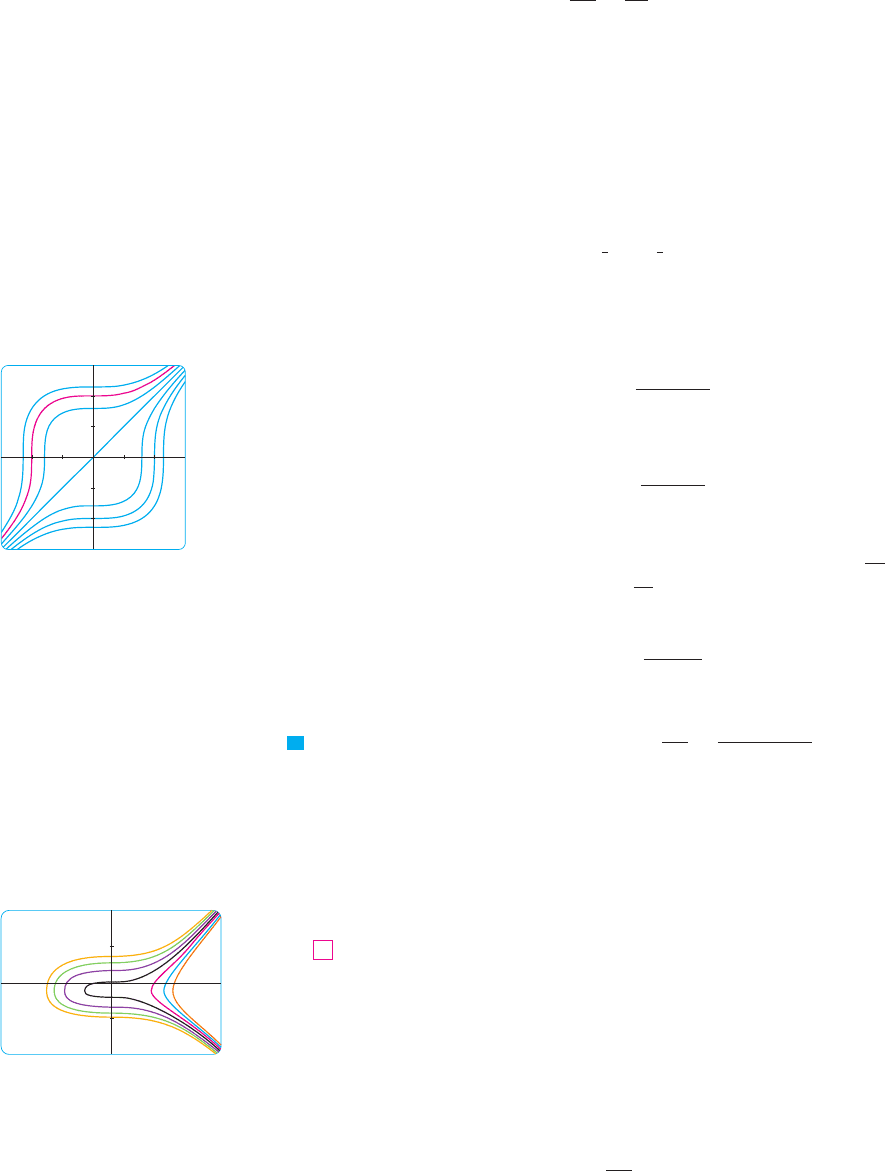
EXAMPLE 1
(a) Solve the differential equation .
(b) Find the solution of this equation that satisfies the initial condition .
SOLUTION
(a) We write the equation in terms of differentials and integrate both sides:
where is an arbitrary constant. (We could have used a constant on the left side and
another constant on the right side. But then we could combine these constants by
writing .)
Solving for , we get
We could leave the solution like this or we could write it in the form
where . (Since is an arbitrary constant, so is .)
(b) If we put in the general solution in part (a), we get . To satisfy the
initial condition , we must have and so .
Thus the solution of the initial-value problem is
M
EXAMPLE 2 Solve the differential equation .
SOLUTION Writing the equation in differential form and integrating both sides, we have
where is a constant. Equation 3 gives the general solution implicitly. In this case it’s
impossible to solve the equation to express explicitly as a function of . M
EXAMPLE 3 Solve the equation .
SOLUTION First we rewrite the equation using Leibniz notation:
dy
dx
! x
2
y
y" ! x
2
y
xy
C
y
2
! sin y ! 2x
3
! C
3
y
!2y ! cos y"dy !
y
6x
2
dx
!2y ! cos y"dy ! 6x
2
dx
dy
dx
!
6x
2
2y ! cos y
V
y !
s
3
x
3
! 8
K ! 8
s
3
K
! 2y!0" ! 2
y!0" !
s
3
K
x ! 0
KCK ! 3C
y !
s
3
x
3
! K
y !
s
3
x
3
! 3C
y
C ! C
2
# C
1
C
2
C
1
C
1
3
y
3
!
1
3
x
3
! C
y
y
2
dy !
y
x
2
dx
y
2
dy ! x
2
dx
y!0" ! 2
dy
dx
!
x
2
y
2
SECTION 10.3 SEPARABLE EQUATIONS
|| ||
617
N Figure 1 shows graphs of several members
of the family of solutions of the differential
equation in Example 1. The solution of the initial-
value problem in part (b) is shown in red.
3
_3
_3 3
F I G U R E 1
N Some computer algebra systems can plot
curves defined by implicit equations. Figure 2
shows the graphs of several members of the
family of solutions of the differential equation
in Example 2. As we look at the curves from left
to right, the values of are , , , , , ,
and .#3
#2#10123C
4
_4
_2 2
F I G U R E 2
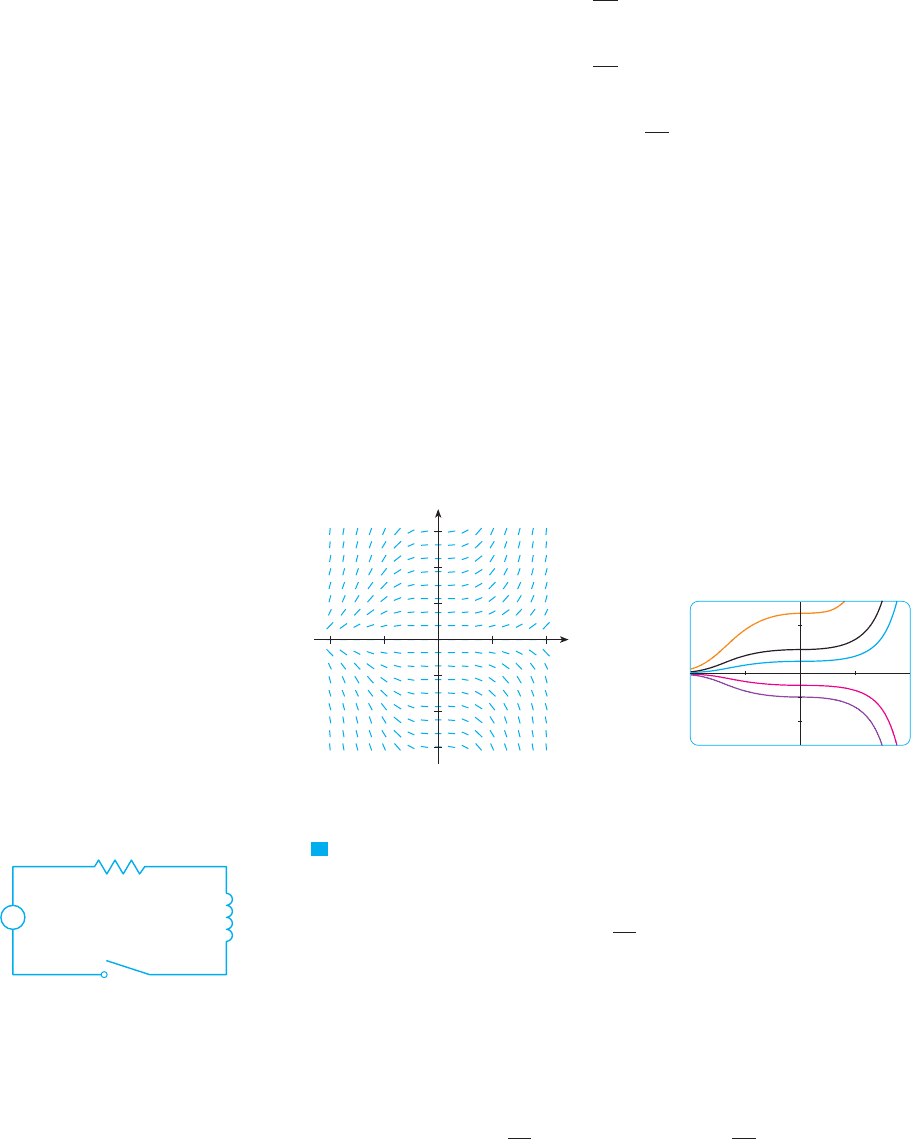
If , we can rewrite it in differential notation and integrate:
This equation defines implicitly as a function of . But in this case we can solve
explicitly for as follows:
so
We can easily verify that the function is also a solution of the given differential
equation. So we can write the general solution in the form
where is an arbitrary constant ( , or , or ). M
EXAMPLE 4 In Section 10.2 we modeled the current in the electric circuit shown
in Figure 5 by the differential equation
Find an expression for the current in a circuit where the resistance is , the induc-
tance is 4 H, a battery gives a constant voltage of 60 V, and the switch is turned on when
. What is the limiting value of the current?
SOLUTION With L ! 4, R ! 12, and , the equation becomes
or
dI
dt
! 15 # 3I 4
dI
dt
! 12I ! 60
E!t" ! 60
t ! 0
12 %
L
dI
dt
! RI ! E!t"
I!t"
V
6
_6
_2 2
F I G U R E 4
F I G U R E 3
2
_4
0
x
y
1 2_1_2
4
6
_2
_6
A ! 0A ! #e
C
A ! e
C
A
y ! Ae
x
3
$3
y ! 0
y ! *e
C
e
x
3
$3
'
y
'
! e
ln
'
y
'
! e
!x
3
$3"!C
! e
C
e
x
3
$3
y
xy
ln
'
y
'
!
x
3
3
! C
y
dy
y
!
y
x
2
dx
dy
y
! x
2
dx y " 0
y " 0
618
|| ||
CHAPTER 10 DIFFERENTIAL EQUATIONS
N If a solution is a function that satisfies
for some , it follows from a
uniqueness theorem for solutions of differential
equations that for all .xy!x" " 0
xy!x" " 0
y
N Figure 3 shows a direction field for the differ-
ential equation in Example 3. Compare it with
Figure 4, in which we use the equation
to graph solutions for several values
of . If you use the direction field to sketch
solution curves with -intercepts , , , ,
and , they will resemble the curves in
Figure 4.
#2
#1125y
A
y ! Ae
x
3
$3
R
E
switch
L
F I G U R E 5
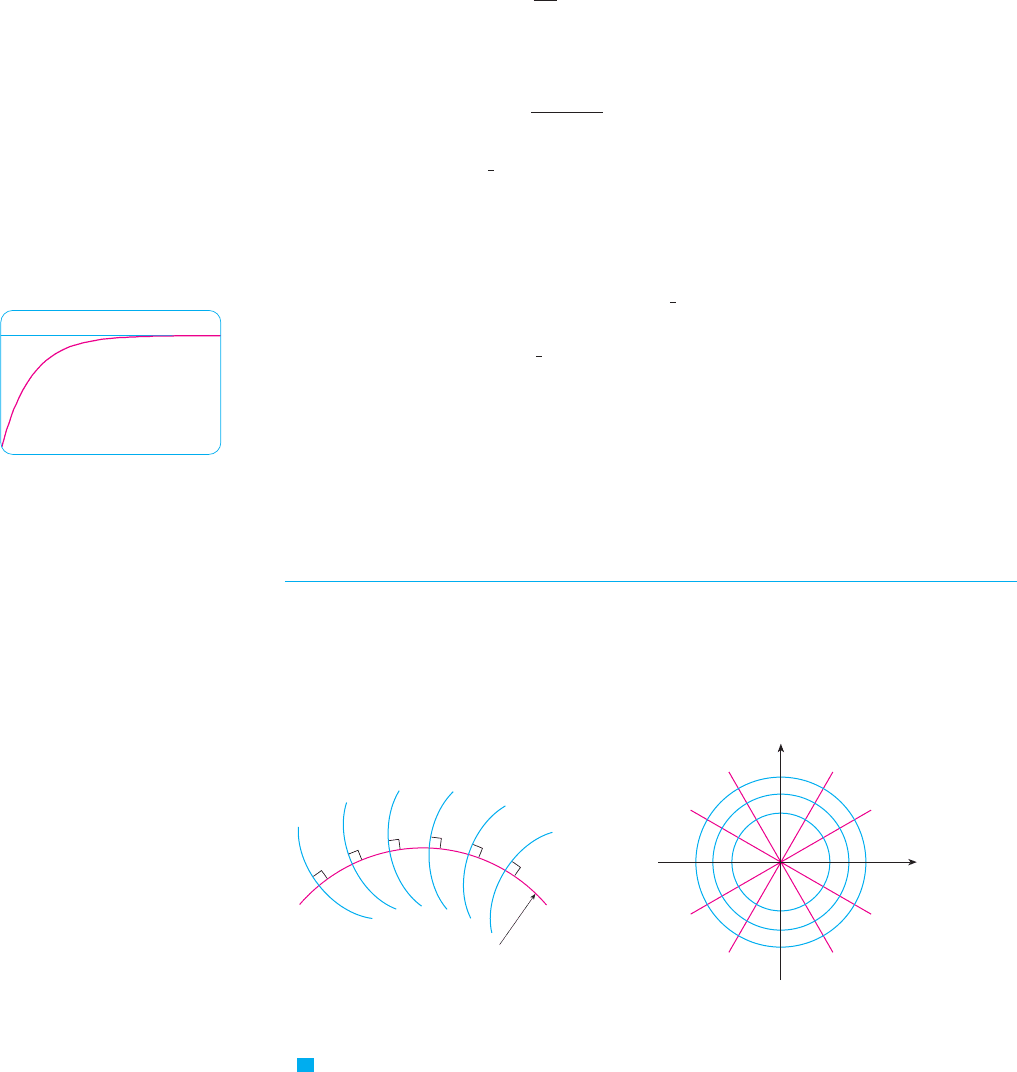
and the initial-value problem is
We recognize this equation as being separable, and we solve it as follows:
Since , we have , so A ! 15 and the solution is
The limiting current, in amperes, is
M
ORTHOGONAL TRA JECTORIES
An orthogonal trajectory of a family of curves is a curve that intersects each curve of the
family orthogonally, that is, at right angles (see Figure 7). For instance, each member of
the family of straight lines through the origin is an orthogonal trajectory of the
family of concentric circles with center the origin (see Figure 8). We say that
the two families are orthogonal trajectories of each other.
EXAMPLE 5 Find the orthogonal trajectories of the family of curves , where
is an arbitrary constant.
SOLUTION The curves form a family of parabolas whose axis of symmetry is
the -axis. The first step is to find a single differential equation that is satisfied by all x
x ! ky
2
k
x ! ky
2
V
x
y
F I G U R E 8
orthogonal
trajectory
F I G U R E 7
x
2
! y
2
! r
2
y ! mx
! 5 # 0 ! 5 lim
t
l
(
I!t" ! lim
t
l
(
!5 # 5e
#3t
" ! 5 # 5 lim
t
l
(
e
#3t
I!t" ! 5 # 5e
#3t
5 #
1
3
A ! 0I!0" ! 0
I ! 5 #
1
3
Ae
#3t
15 # 3I ! *e
#3C
e
#3t
! Ae
#3t
'
15 # 3I
'
! e
#3!t!C"
#
1
3
ln
'
15 # 3I
'
! t ! C
!15 # 3I " 0"
y
dI
15 # 3I
!
y
dt
I!0" ! 0
dI
dt
! 15 # 3I
SECTION 10.3 SEPARABLE EQUATIONS
|| ||
619
N Figure 6 shows how the solution in Example 4
(the current) approaches its limiting value. Com-
parison with Figure 11 in Section 10.2 shows
that we were able to draw a fairly accurate
solution curve from the direction field.
6
0
2.5
y=5
F I G U R E 6
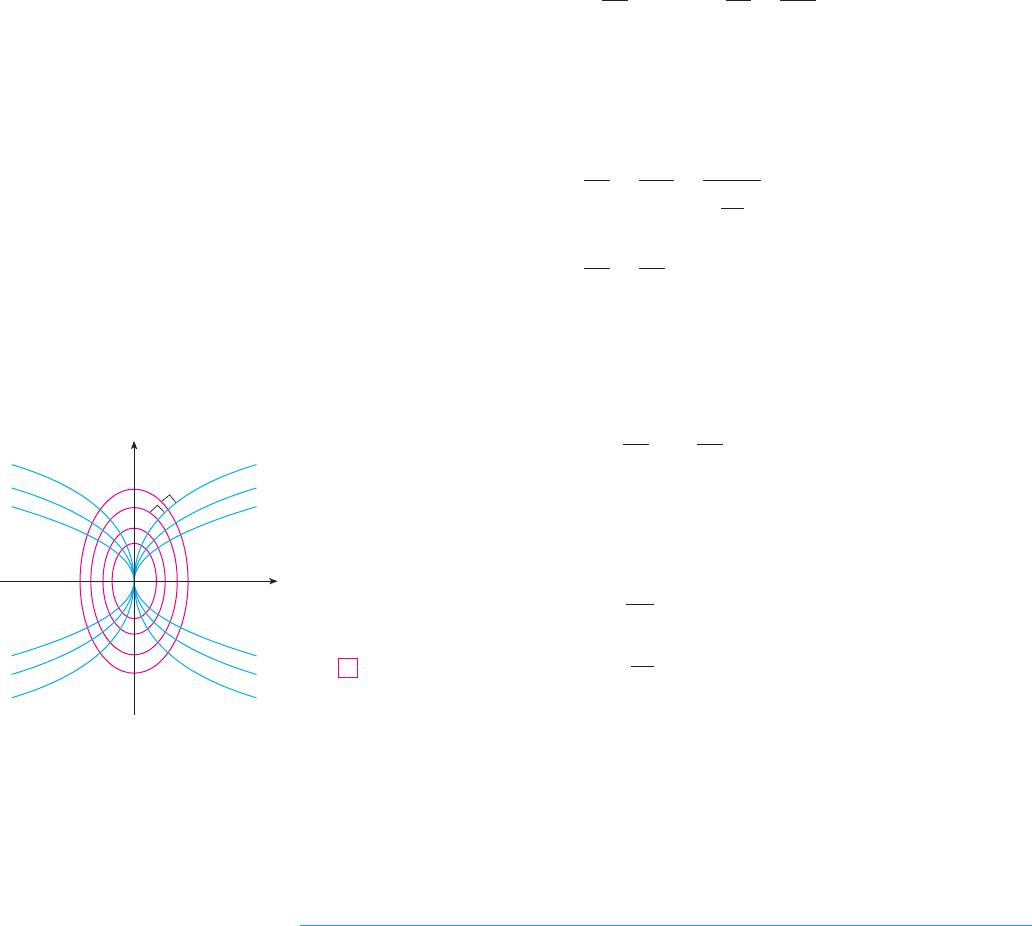
members of the family. If we differentiate , we get
This differential equation depends on , but we need an equation that is valid for all
values of simultaneously. To eliminate we note that, from the equation of the given
general parabola , we have and so the differential equation can be
written as
or
This means that the slope of the tangent line at any point on one of the parabolas is
. On an orthogonal trajectory the slope of the tangent line must be the nega-
tive reciprocal of this slope. Therefore the orthogonal trajectories must satisfy the differ-
ential equation
This differential equation is separable, and we solve it as follows:
where is an arbitrary positive constant. Thus the orthogonal trajectories are the family
of ellipses given by Equation 4 and sketched in Figure 9.
M
Orthogonal trajectories occur in various branches of physics. For example, in an elec-
trostatic field the lines of force are orthogonal to the lines of constant potential. Also,
the streamlines in aerodynamics are orthogonal trajectories of the velocity-equipotential
curves.
MIXING PROBLEMS
A typical mixing problem involves a tank of fixed capacity filled with a thoroughly mixed
solution of some substance, such as salt. A solution of a given concentration enters the tank
at a fixed rate and the mixture, thoroughly stirred, leaves at a fixed rate, which may differ
from the entering rate. If denotes the amount of substance in the tank at time t, then
is the rate at which the substance is being added minus the rate at which it is being
removed. The mathematical description of this situation often leads to a first-order sepa-
rable differential equation. We can use the same type of reasoning to model a variety of
phenomena: chemical reactions, discharge of pollutants into a lake, injection of a drug into
the bloodstream.
y"!t"
y!t"
C
x
2
!
y
2
2
! C
4
y
2
2
! #x
2
! C
y
y dy ! #
y
2x dx
dy
dx
! #
2x
y
y" ! y$!2x"
!x, y"
dy
dx
!
y
2x
dy
dx
!
1
2ky
!
1
2
x
y
2
y
k ! x$y
2
x ! ky
2
kk
k
dy
dx
!
1
2ky
or1 ! 2ky
dy
dx
x ! ky
2
620
|| ||
CHAPTER 10 DIFFERENTIAL EQUATIONS
x
y
F I G U R E 9
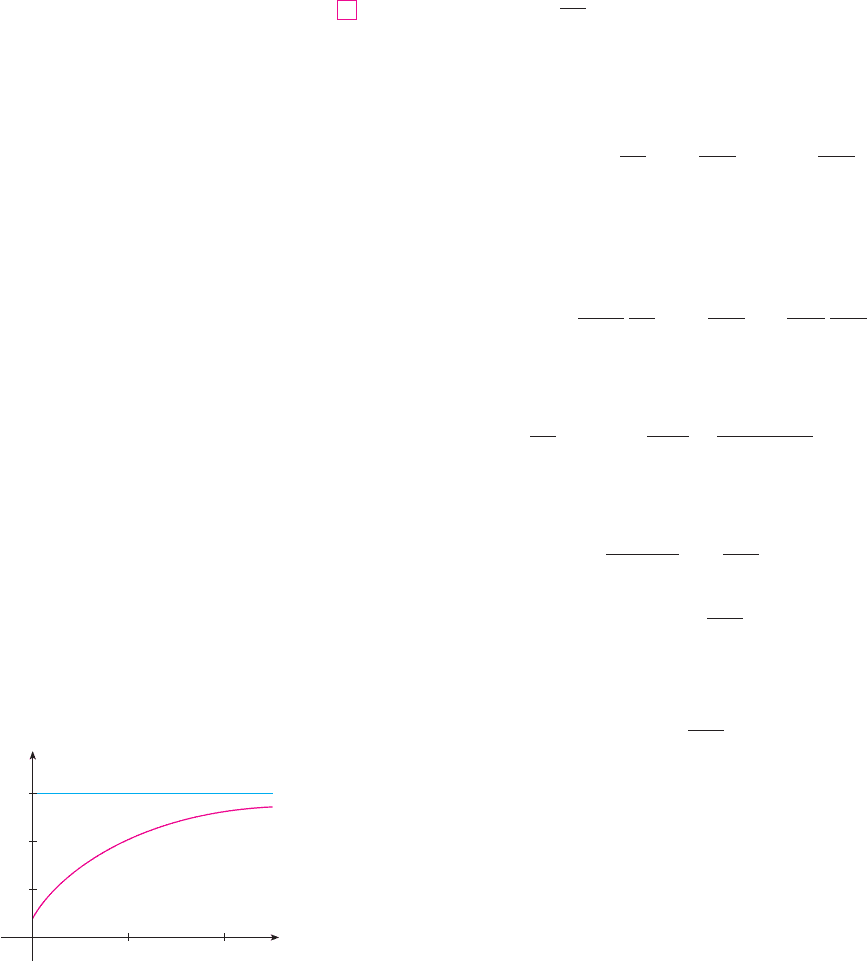
EXAMPLE 6 A tank contains 20 kg of salt dissolved in 5000 L of water. Brine that con-
tains 0.03 kg of salt per liter of water enters the tank at a rate of 25 L$min. The solution
is kept thoroughly mixed and drains from the tank at the same rate. How much salt
remains in the tank after half an hour?
SOLUTION Let be the amount of salt (in kilograms) after minutes. We are given that
and we want to find . We do this by finding a differential equation satis-
fied by . Note that is the rate of change of the amount of salt, so
where (rate in) is the rate at which salt enters the tank and (rate out) is the rate at which
salt leaves the tank. We have
The tank always contains 5000 L of liquid, so the concentration at time is
(measured in kilograms per liter). Since the brine flows out at a rate of 25 L$min, we
have
Thus, from Equation 5, we get
Solving this separable differential equation, we obtain
Since , we have , so
Therefore
Since is continuous and and the right side is never 0, we deduce that
is always positive. Thus and so
The amount of salt after 30 min is
M
y!30" ! 150 # 130e
#30$200
# 38.1 kg
y!t" ! 150 # 130e
#t$200
'
150 # y
'
! 150 # y150 # y!t"
y!0" ! 20y!t"
'
150 # y
'
! 130e
#t$200
#ln
'
150 # y
'
!
t
200
# ln 130
#ln 130 ! Cy!0" ! 20
#ln
'
150 # y
'
!
t
200
! C
y
dy
150 # y
!
y
dt
200
dy
dt
! 0.75 #
y!t"
200
!
150 # y!t"
200
rate out !
%
y!t"
5000
kg
L
&%
25
L
min
&
!
y!t"
200
kg
min
y!t"$5000t
rate in !
%
0.03
kg
L
&%
25
L
min
&
! 0.75
kg
min
dy
dt
! !rate in" # !rate out"
5
dy$dty!t"
y!30"y!0" ! 20
ty!t"
SECTION 10.3 SEPARABLE EQUATIONS
|| ||
621
N Figure 10 shows the graph of the function
of Example 6. Notice that, as time goes by, the
amount of salt approaches 150 kg.
y!t"
t
y
0
200 400
50
100
150
F I G U R E 1 0
